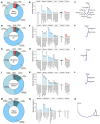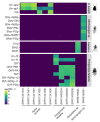Mining Public Data to Investigate the Virome of Neglected Pollinators and Other Floral Visitors
- PMID: 37766257
- PMCID: PMC10535300
- DOI: 10.3390/v15091850
Mining Public Data to Investigate the Virome of Neglected Pollinators and Other Floral Visitors
Abstract
This study reports the virome investigation of pollinator species and other floral visitors associated with plants from the south of Bahia: Aphis aurantii, Atrichopogon sp., Dasyhelea sp., Forcipomyia taiwana, and Trigona ventralis hoozana. Studying viruses in insects associated with economically important crops is vital to understand transmission dynamics and manage viral diseases that pose as threats for global food security. Using literature mining and public RNA next-generation sequencing data deposited in the NCBI SRA database, we identified potential vectors associated with Malvaceae plant species and characterized the microbial communities resident in these insects. Bacteria and Eukarya dominated the metagenomic analyses of all taxon groups. We also found sequences showing similarity to elements from several viral families, including Bunyavirales, Chuviridae, Iflaviridae, Narnaviridae, Orthomyxoviridae, Rhabdoviridae, Totiviridae, and Xinmoviridae. Phylogenetic analyses indicated the existence of at least 16 new viruses distributed among A. aurantii (3), Atrichopogon sp. (4), Dasyhelea sp. (3), and F. taiwana (6). No novel viruses were found for T. ventralis hoozana. For F. taiwana, the available libraries also allowed us to suggest possible vertical transmission, while for A. aurantii we followed the infection profile along the insect development. Our results highlight the importance of studying the virome of insect species associated with crop pollination, as they may play a crucial role in the transmission of viruses to economically important plants, such as those of the genus Theobroma, or they will reduce the pollination process. This information may be valuable in developing strategies to mitigate the spread of viruses and protect the global industry.
Keywords: Malvaceae; insects; pollinators; virome.
Conflict of interest statement
The authors declare no conflict of interest.
Figures







Similar articles
-
Virome Analysis Reveals Diverse and Divergent RNA Viruses in Wild Insect Pollinators in Beijing, China.Viruses. 2022 Jan 24;14(2):227. doi: 10.3390/v14020227. Viruses. 2022. PMID: 35215821 Free PMC article.
-
The Viromes of Six Ecosystem Service Provider Parasitoid Wasps.Viruses. 2023 Dec 16;15(12):2448. doi: 10.3390/v15122448. Viruses. 2023. PMID: 38140687 Free PMC article.
-
The pollen virome: A review of pollen-associated viruses and consequences for plants and their interactions with pollinators.Am J Bot. 2023 Jun;110(6):e16144. doi: 10.1002/ajb2.16144. Epub 2023 Mar 16. Am J Bot. 2023. PMID: 36924316 Review.
-
Non-Bee Insects as Visitors and Pollinators of Crops: Biology, Ecology, and Management.Annu Rev Entomol. 2020 Jan 7;65:391-407. doi: 10.1146/annurev-ento-011019-025055. Epub 2019 Oct 14. Annu Rev Entomol. 2020. PMID: 31610136 Review.
-
Viral metagenomics of hematophagous insects collected in the Carajas mining complex, Pará State, Brazil.Acta Trop. 2025 Mar;263:107551. doi: 10.1016/j.actatropica.2025.107551. Epub 2025 Feb 10. Acta Trop. 2025. PMID: 39938727
Cited by
-
Transcriptome Analysis Reveals a Diverse Range of Novel Viruses in Australian Sugarcane Soldier Fly (Inopus flavus) Larvae.Viruses. 2024 Mar 27;16(4):516. doi: 10.3390/v16040516. Viruses. 2024. PMID: 38675859 Free PMC article.
References
-
- Ollerton J., Winfree R., Tarrant S. How many flowering plants are pollinated by animals? Oikos. 2011;120:321–326. doi: 10.1111/j.1600-0706.2010.18644.x. - DOI
-
- Kearns C.A., Inouye D.W., Waser N.M. ENDANGERED MUTUALISMS: The Conservation of Plant-Pollinator Interactions. Annu. Rev. Ecol. Syst. 1998;29:83–112. doi: 10.1146/annurev.ecolsys.29.1.83. - DOI
Publication types
MeSH terms
LinkOut - more resources
Full Text Sources

